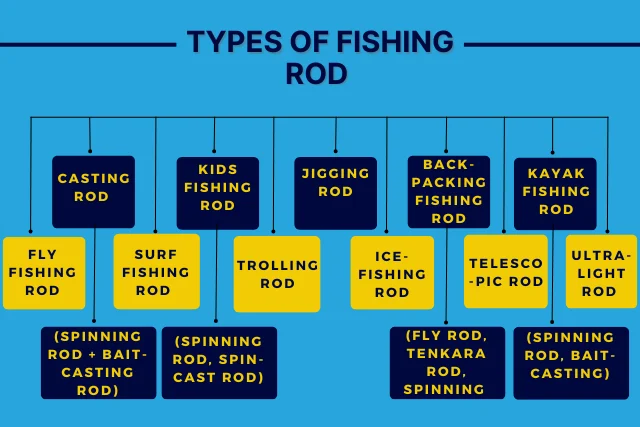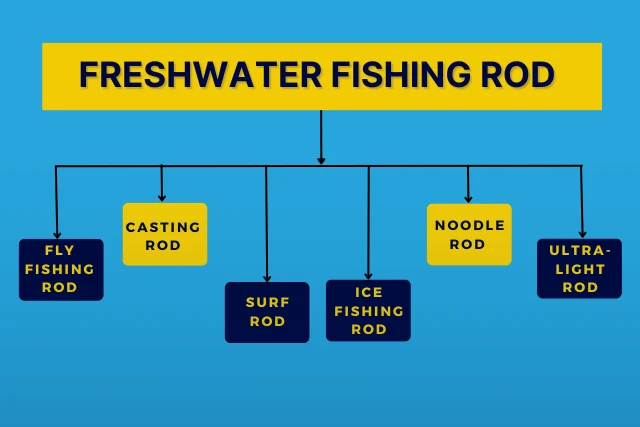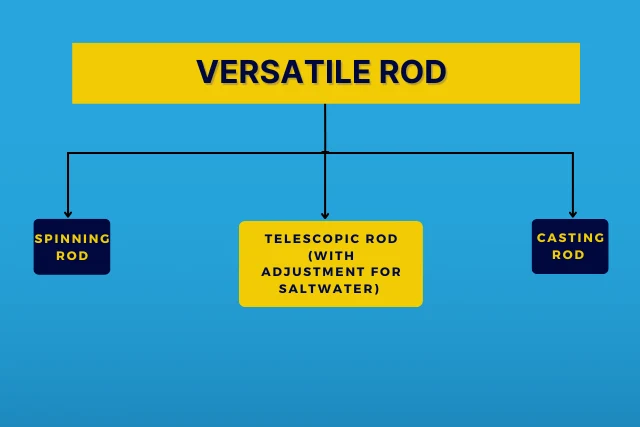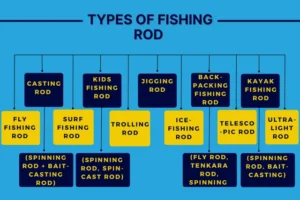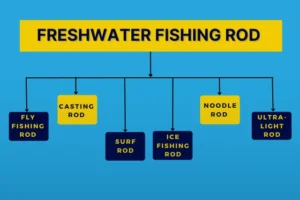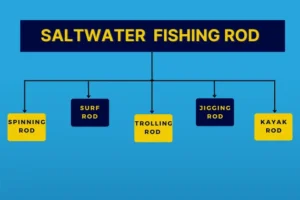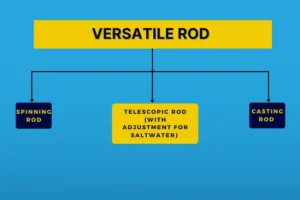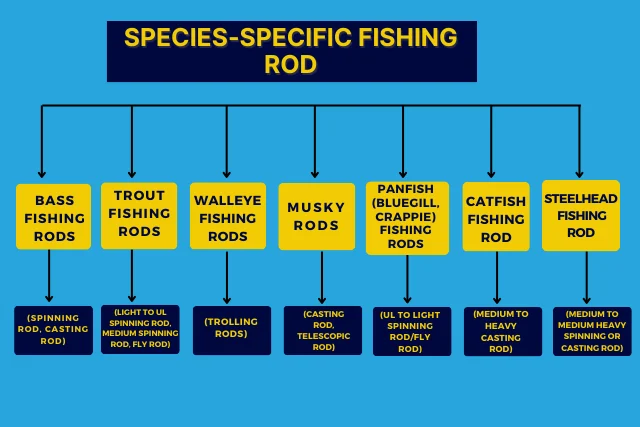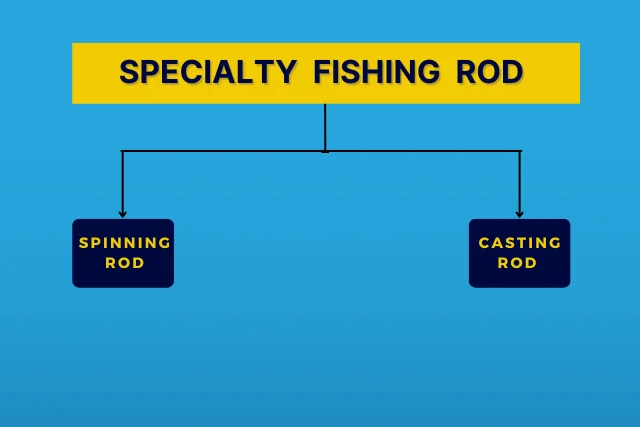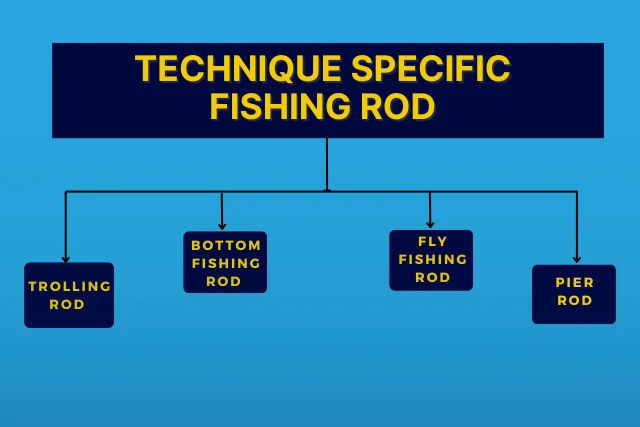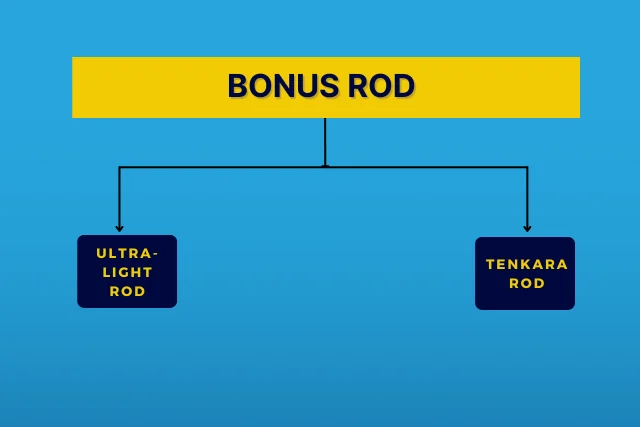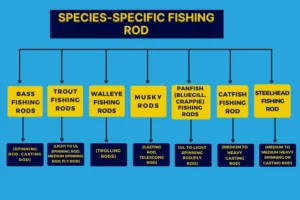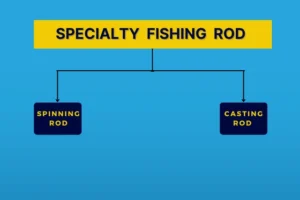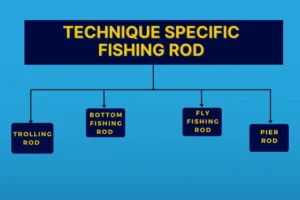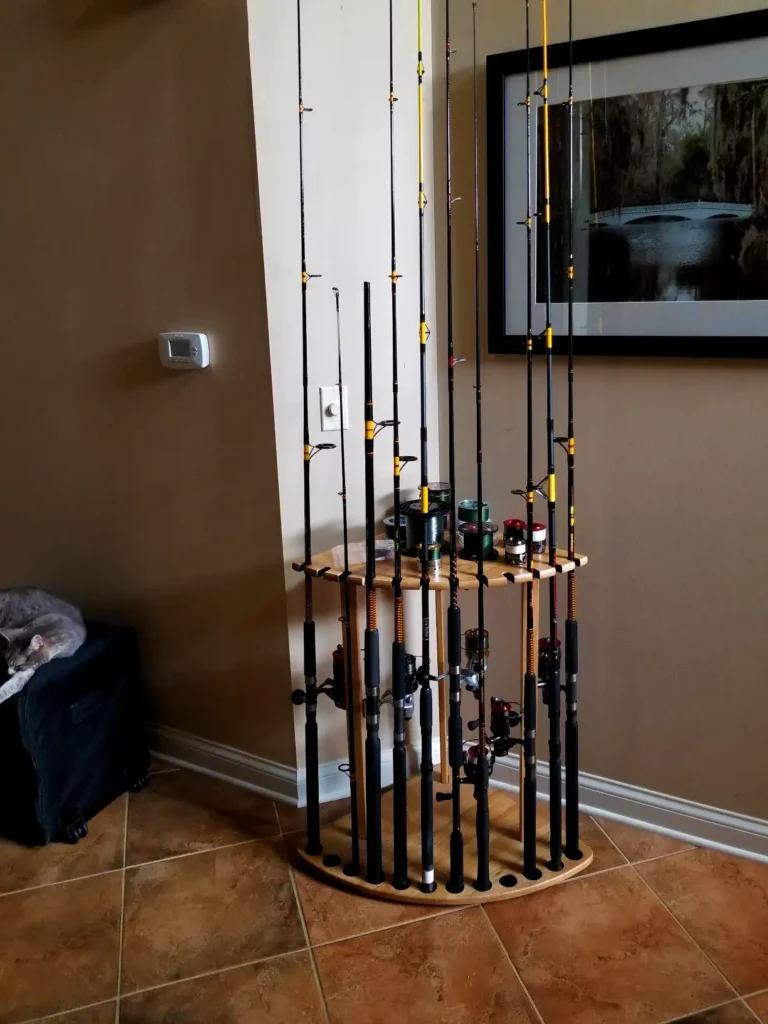
We can’t take any fishing rod and go fishing. There are many types of fishing rods, and each type is designed by considering different situations like water type, Versatility, technique, and targeted species.
If you are new to fishing, you should start by knowing the basics, from learning the parts of a fishing rod to understanding different fishing rods. Choosing the best fish rod and enhancing your success in the water is essential.
Freshwater or saltwater, we’ve covered you with rods for different places and fish. And guess what? Some rods are like superheroes that can do it all – versatile and handy. We’ll even explore rods for specific fish like bass, trout, and catfish. It’s like having the right tool for the right job!
Freshwater Fishing Rod:
Fly-Fishing Rod:
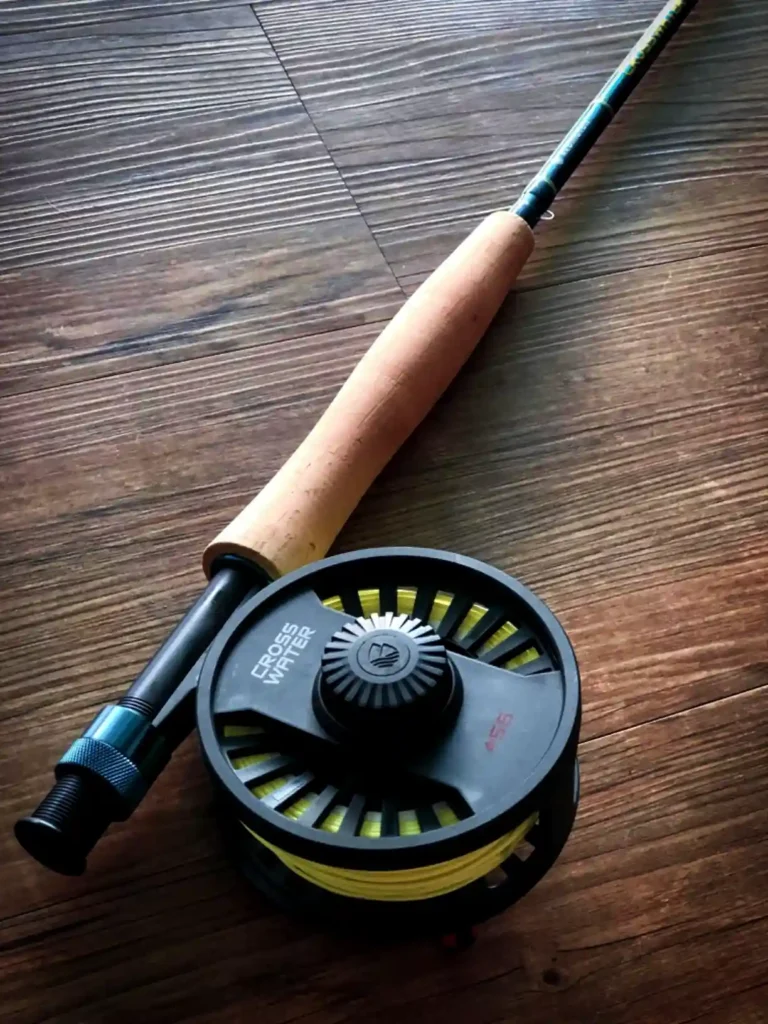
A fly-fishing rod is made for fly fishing, offering Versatility across sizes and lengths to target a wide range of fish species. These rods, typically longer than their spin or baitcasting counterparts, commonly measure around 9 feet but can extend up to 14 feet.
In a fly fishing rod setup, the rod serves as a lever to delicately present the fly line to fish. Unlike spin or baitcasting rods, fly rods are uniquely suited for fly reels. These reels operate differently, accommodating thicker and weighted fly lines designed for casting.
Fly lines come in various types, such as floating, sinking, and sink tips, each catering to specific fishing conditions. The weighted nature of the fly line enhances casting precision, allowing anglers to deliver subtle presentations to their intended targets.
Common Applications:
- Trout fishing
- Steelhead Fishing
- Salmon fishing
- Fly fishing in exclusive waters
Advantages:
- Offering a unique experience compared to traditional rod and reel methods.
- The ability to delicately present flies, making it possible to reach fish that might be challenging to target with other types of rods
Challenges:
- Limited casting distance compared to other fishing methods.
- It could be better for casting large weights and lures.
- Wind poses a more significant challenge in fly fishing.
- Learning fly fishing is generally more challenging compared to other fishing techniques. Learn the difference between fly fishing and. Regular fishing.
Ice- Fishing rod:
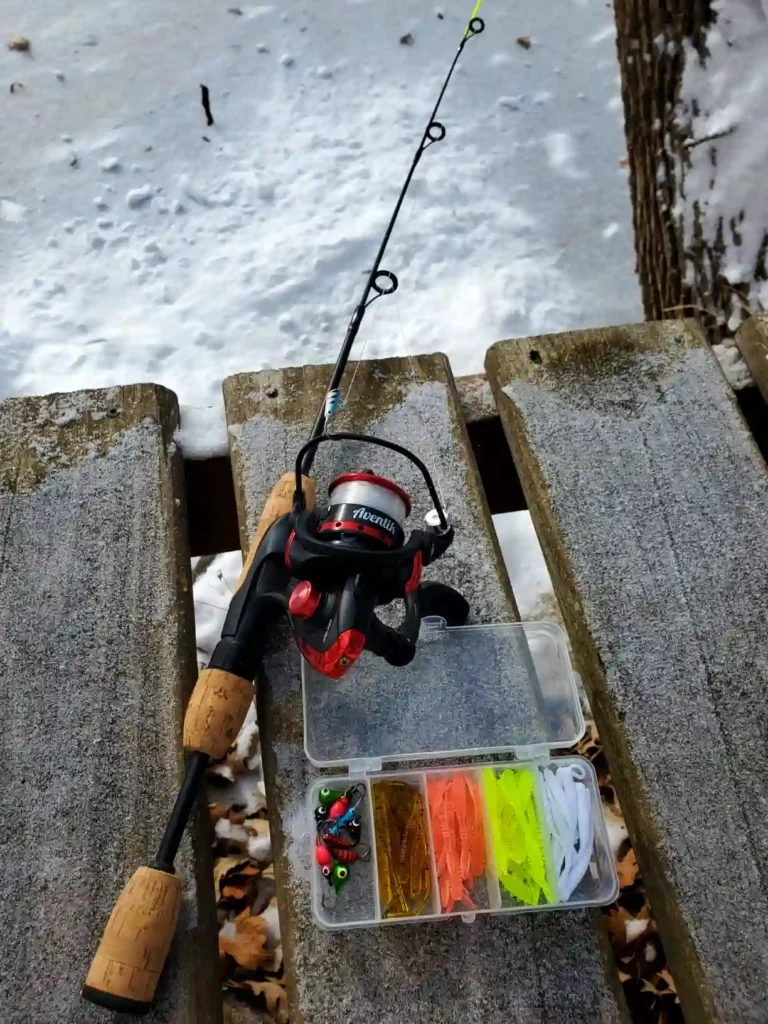
Ice fishing rods are typically short spin rods explicitly designed for the unique conditions of ice fishing. Their shorter length allows anglers to reel in their catch effortlessly from just above the ice fishing hole. So, these rods are primarily crafted for ice fishing; they excel in this specialized purpose. Fighting a fish beneath the ice can be an exciting experience with these rods.
Noodle Fishing rod:
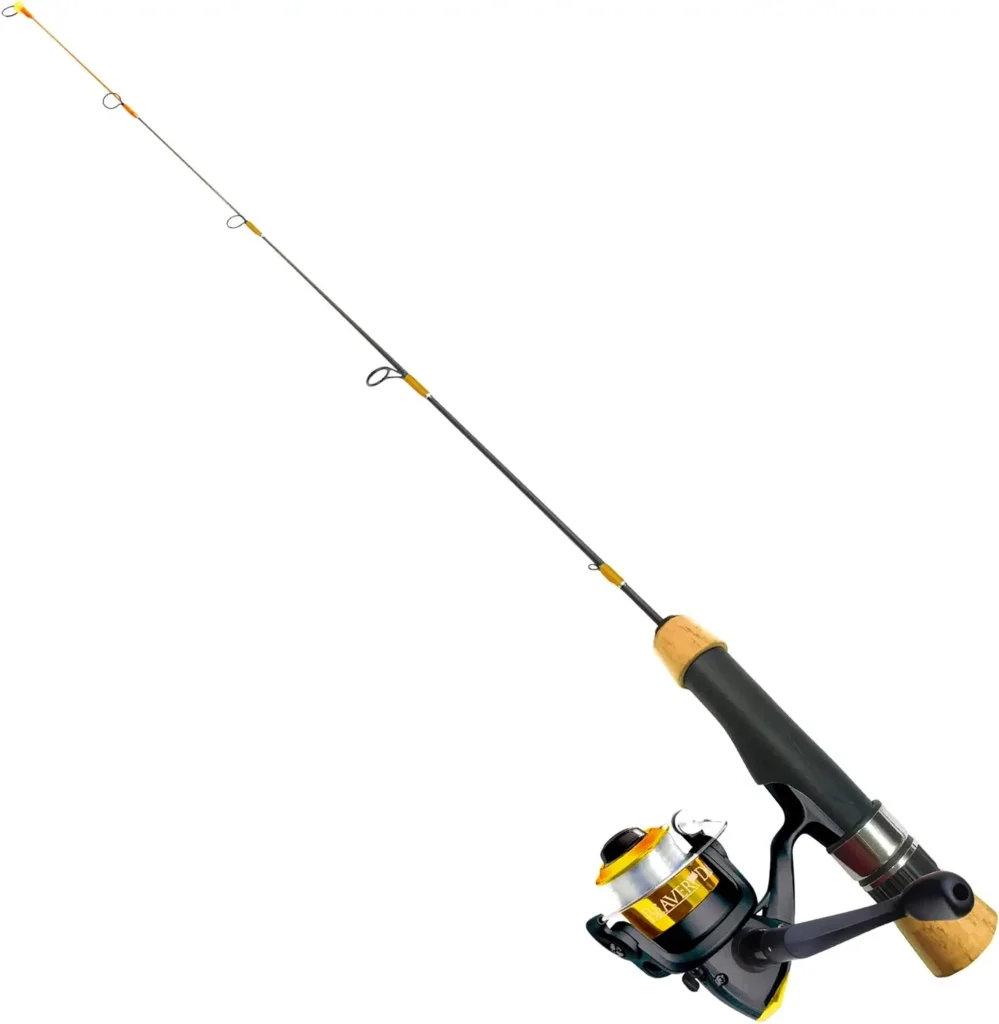
A noodle rod is a fishing rod known for its highly flexible and slow action. These rods are designed to provide a delicate presentation and are commonly used when finesse is required.
Common Applications:
- Salmon fishing
- Steelhead fishing
Advantages:
- Noodle rods excel when light lines are required, making them popular for targeting salmon and steelhead trout.
- Noodle rods are susceptible, allowing anglers to detect even the subtlest bites.
- The slow action of noodle rods enables anglers to present baits or lures delicately, making them ideal for situations where finesse is necessary.
- Noodle rods are designed to absorb the pressure from the fish, helping to keep light lines, such as four lb. test lines, intact during a fight.
Challenges:
- Noodle rods are not designed for long casting distances.
- Due to their light and flexible nature, noodle rods may not be suitable for casting heavy lures or handling large baits.
- Using noodle rods effectively requires a certain skill level, and beginners may find them more challenging.
Saltwater Fishing rods:
Surf rod:
Surf fishing rods are a staple in sea fishing, designed with a durable butt and extended length. The added length allows anglers to cast a heavy bait rig easily to the desired area.
While only universally suitable for some anglers. So, as an expert, I recommend you take two surf fishing rod setups. But after some experience, using only one surf fishing rod setup may give you Versatility.
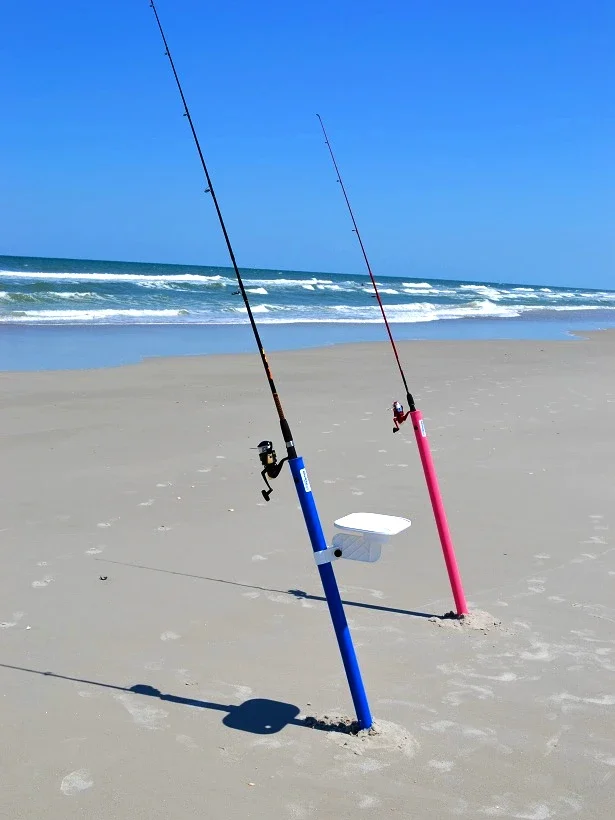
Common Applications:
- Beach Fishing
- Shallow-sea fishing for different species
Advantages:
- Large Casting Distance
- Capable of handling large fish
Challenges:
- Surf rods tend to be weighty, making them less suitable for anglers seeking lightweight and portable options.
- It may be impractical for use in smaller bodies of water like rivers or lakes.
Jigging rods:
A jigging rod is a specialized fishing rod designed for the technique of jigging. Jigging involves vertically jerking or “jigging” a lure or bait up and down in the water to attract fish. Jigging rods often come in various lengths, and the choice depends on the depth of the water and the species being targeted. Shorter rods are suitable for shallower waters, while longer rods are used for deeper jigging.
Common Applications:
- Jigging rods are frequently used in deep-sea fishing to target species like tuna, snapper, and grouper.
- Specially designed jigging rods are also used for ice fishing, where anglers vertically jig lures through the ice to entice fish.
Advantages:
- Jigging rods provide excellent control over the movement of jigs, allowing anglers to mimic the behavior of prey and attract predatory fish.
- It is suitable for various environments, including saltwater and freshwater, making it adaptable to different fishing conditions.
Challenges:
- Jigging rods are optimized for the jigging technique and may not perform as well as other fishing styles.
- Jigging requires some skill and practice, making it less beginner-friendly than other fishing methods.
Kayak-Fishing rod:
The Kayak fishing rod is designed for anglers who love to fish from a kayak. Because of the adapted features of these rods, fishing on kayaks is possible where the mobility factor is limited.
Kayak fishing rods tend to be shorter than fishing rods. The most typical fishing rods used for this purpose are spinning and baitcasting rods with adaptative features.
Fishing rods are known for Versatility:
Some rods are versatile and can be used in fresh and saltwater with appropriate adjustments; we call them versatile fishing rods.
Material and component choices (like corrosion resistance) differ for saltwater use.
Spinning rod:
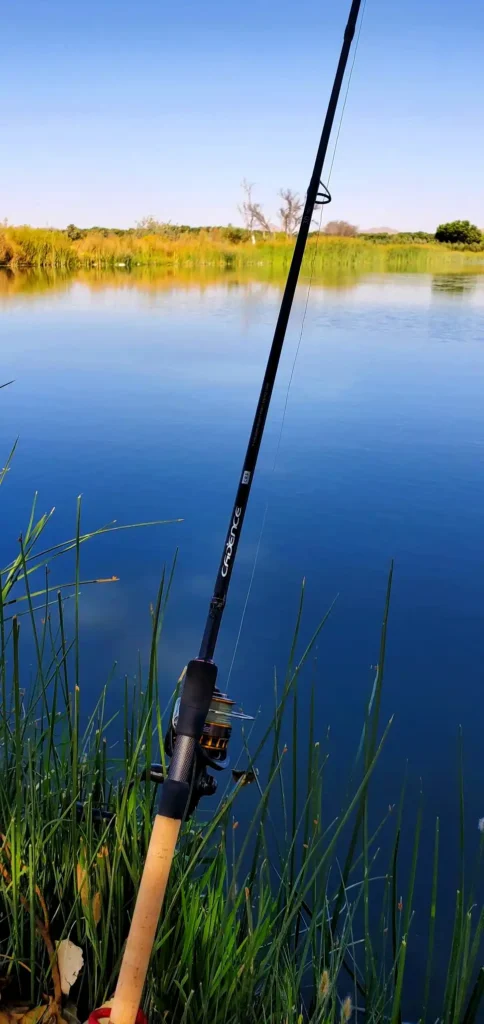
Fishing with spinning rods is one of the most common choices among anglers. Its design resembles other casting rods but has added features and benefits. Spin rods offer users the advantage of holding it with their dominant hand, providing increased stability and power. When casting and reeling in, the reel is positioned at the bottom end of the rod.
Operating this rod is relatively straightforward. Its versatile features make it an excellent choice for fishing in lakes, rivers, or boats.
Common Applications:
- Highly Versatile
Advantages:
- Variety present in reel and rod weight and length
- Easy to handle the tangles
Challenges:
- It’s not kid-friendly. Kids face trouble while using it.
Casting rod:
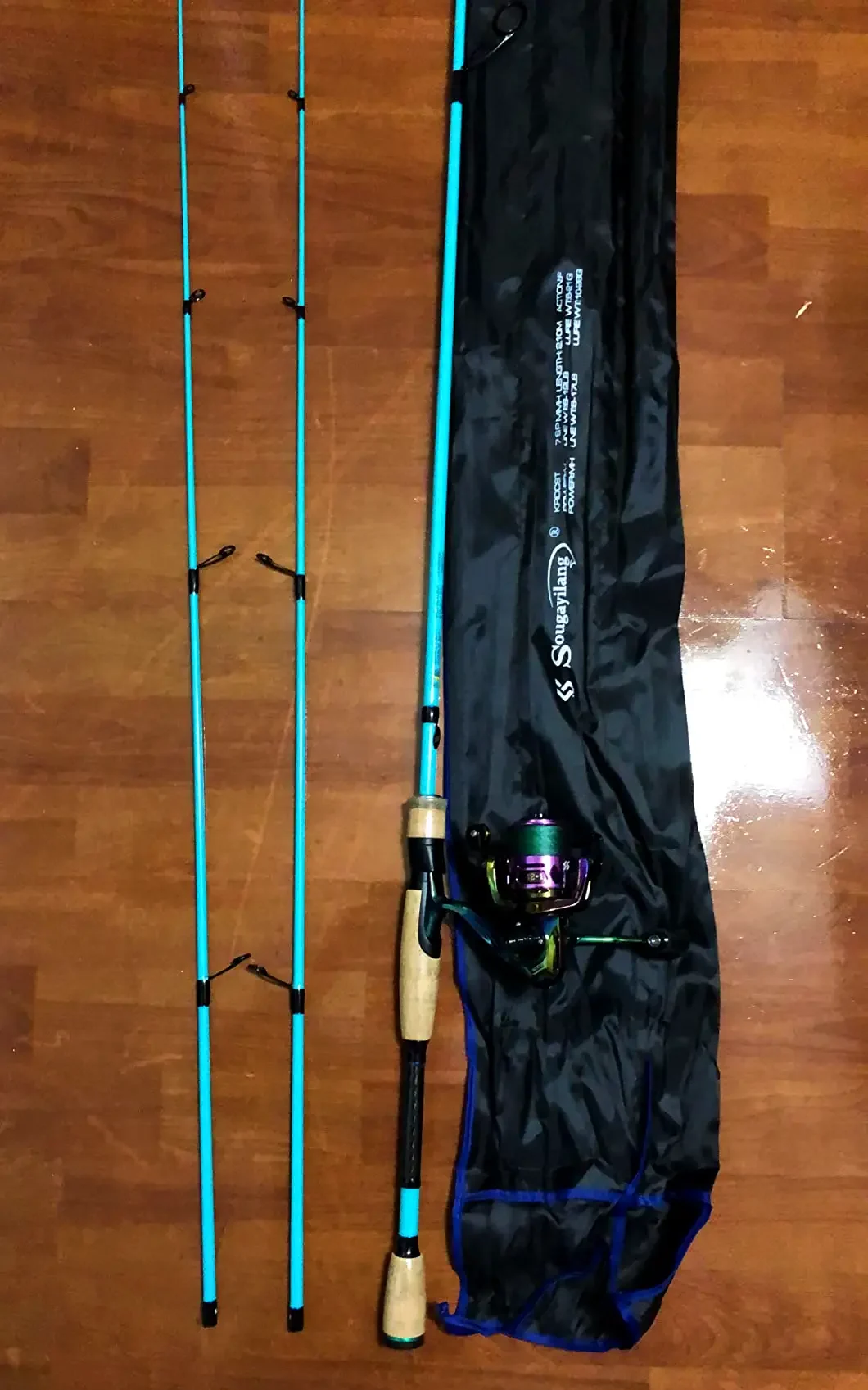
A casting rod is a fishing rod designed to work with baitcasting reels. It has a reel seat on the top of the rod, with guides often positioned above the blank. Casting rods have a “trigger” for the first finger, enhancing control and stability during use.
Common Applications:
- Widely popular among bass anglers.
- Known for their strength, casting rods are favored when targeting aggressive predators like muskies and pikes.
- They are commonly used for saltwater species such as redfish, tarpon, tuna, and sharks, especially when robust tackle is required.
Advantages:
- Designed for heavier lines, casting rods handle substantial stress and provide durability.
- Equipped with robust drag systems, casting rods protect fishing lines from the forceful pulls of large and robust fish.
- With fast actions, casting rods ensure positive hooksets, which are crucial for worm and soft plastic fishing techniques.
- Casting rods enables anglers to muscle fish out of cover and control powerful adversaries.
Challenges:
- Baitcasting reels, commonly paired with casting rods, have a learning curve, especially for beginners. Some may need help with backlash issues.
- While casting rods offer precise casting control, achieving mastery in accuracy and distance requires practice and skill.
- Casting rods may be less forgiving with lighter lures than spinning rods, demanding a more refined technique.
Telescopic rod (with adjustment for saltwater):
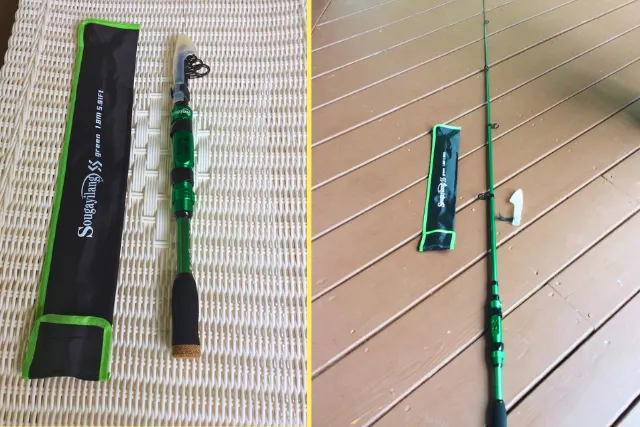
Telescopic fishing rods are ingeniously designed to collapse into a compact size or extend into a longer bar. This feature becomes a significant advantage when you’re on foot, cycling, using minimal car space, or relying on public transit.
The telescopic design proves particularly beneficial in surf angling, where extended rods of up to 14 feet are often required. When selecting a telescopic rod, it’s essential to maintain the joints meticulously clean, as dirt or sand could cause damage, compromising the rod’s flexibility.
Common Use Cases:
- Ideal for backpacking or camping trips
- Convenient for day hiking
- Perfect for travelers or those with limited car space
Advantages:
- Easy to travel with due to its telescopic design
- Highly versatile, suitable for various fishing environments
Challenges:
- Casting performance may not match traditional rods, often affected by the telescoping design.
Specialty Rod:
Drift rod:
A drift fishing rod is a specialized technique that uses natural current. The natural current of streams or rivers carries bait or lures downstream, imitating the movement of raw food sources for fish. Particularly effective for targeting bottom-dwelling species like salmon, steelhead, trout, and sturgeon, this method involves strategic casting to let the current guide the offering.
Common Drift Fishing Rods:
- Steelhead Drift Rods:
- Trout Drift Rods:
- Centerpin Rods:
Common Applications:
- Drift fishing excels in rivers and streams with moderate to fast currents.
- Effective for targeting bottom-dwelling fish feeding on drifting food, such as salmon, steelhead, trout, sturgeon, and catfish.
- While applicable in lakes and reservoirs, its efficacy is generally lower than moving water.
Advantages:
- Natural and effective presentation of bait or lures to fish.
- It covers a large area quickly and efficiently.
- Provides a relaxing and enjoyable fishing experience.
Challenges:
- Drift fishing has a learning curve, especially in fast-moving water.
- Requires skill in reading the water to position bait or lures effectively.
- Practice is needed to control the drift and keep the offering in the strike zone.
Telescopic rod:
As described above, this is the easiest-to-carry rod. This rod is for you if you like to fish in different fishing spots.
Technique-Specific Rod:
Trolling rod:
Trolling rods serve the purpose of moving boats during fishing. Trolling involves letting your lure move through the water as your boat moves.
Typically, trolling rods are sturdy with large reels, facilitating the use of fishing lines. Primarily designed for trolling, these rods may be less versatile for other fishing techniques.
Common Applications:
- Ideal for big lake fishing
- Suitable for ocean fishing
- Effective for pond fishing
Advantages:
- It is excellently suited for trolling behind a boat, outperforming traditional spin-casting rods.
Challenges:
- Limited Versatility, primarily designed and used for trolling purposes.
Bottom fishing rod:
Rods used for bottom fishing specialize in this fishing technique, where the bait or lure is presented on or near the seabed or lake floor.
The choice of rods for bottom fishing depends on the type of water (saltwater or freshwater), the target species, and the specific conditions.
Common Applications:
- Bottom fishing rods are commonly used in saltwater environments, particularly for targeting species near the ocean floor.
- When fishing in deeper waters for bottom-dwelling species, these rods are essential for reaching the desired depth.
- Bottom fishing is effective around reefs and underwater structures where many bottom-dwelling species congregate.
Advantages:
- Bottom fishing rods are highly effective for targeting species inhabiting the water column’s bottom layers.
- While specialized for bottom fishing, these rods can also be used for other applications, making them versatile for various saltwater angling situations.
Challenges:
- These rods are not optimal for fishing near the surface or for techniques that involve keeping lures or baits suspended in the water column.
Fly fishing rod:
As described earlier, fly fishing rods are ideal for freshwater conditions. After learning about the basics of fly-fishing rods, you should also learn different techniques using fly-fishing rods. Fly fishing with spinning rods is the most popular technique among anglers.
Pier Fishing rod:
A pier fishing rod is purpose-built to address the demands and opportunities that arise when fishing from a pier. Pier fishing entails casting from an elevated platform, contending with varying water depths, and the possibility of encountering larger fish species near the structure. Casting, surf, and telescopic rods are the best pier fishing rods.
Here is the complete pier fishing setup guide with additional tips.
Bonus Rods:
Ultra-light fishing rod:
As the name suggests, an ultralight fishing rod tends to be slender and lightweight for delicate presentations, enhancing the enjoyment of catching smaller fish species.
These rods are versatile and found in various types, such as spin, fly, or other fishing rods.
Common Applications:
- Trout Fishing:
- Small Warm Water Fishing
- Backpacking or Camping
Advantages:
- Enhanced Fun with Small Fish.
- Delicate Presentation.
- Portability.
Challenges:
- Challenges with Big Fish
- Durability Concerns
- Casting Distance Limitations
Tenkara rod:
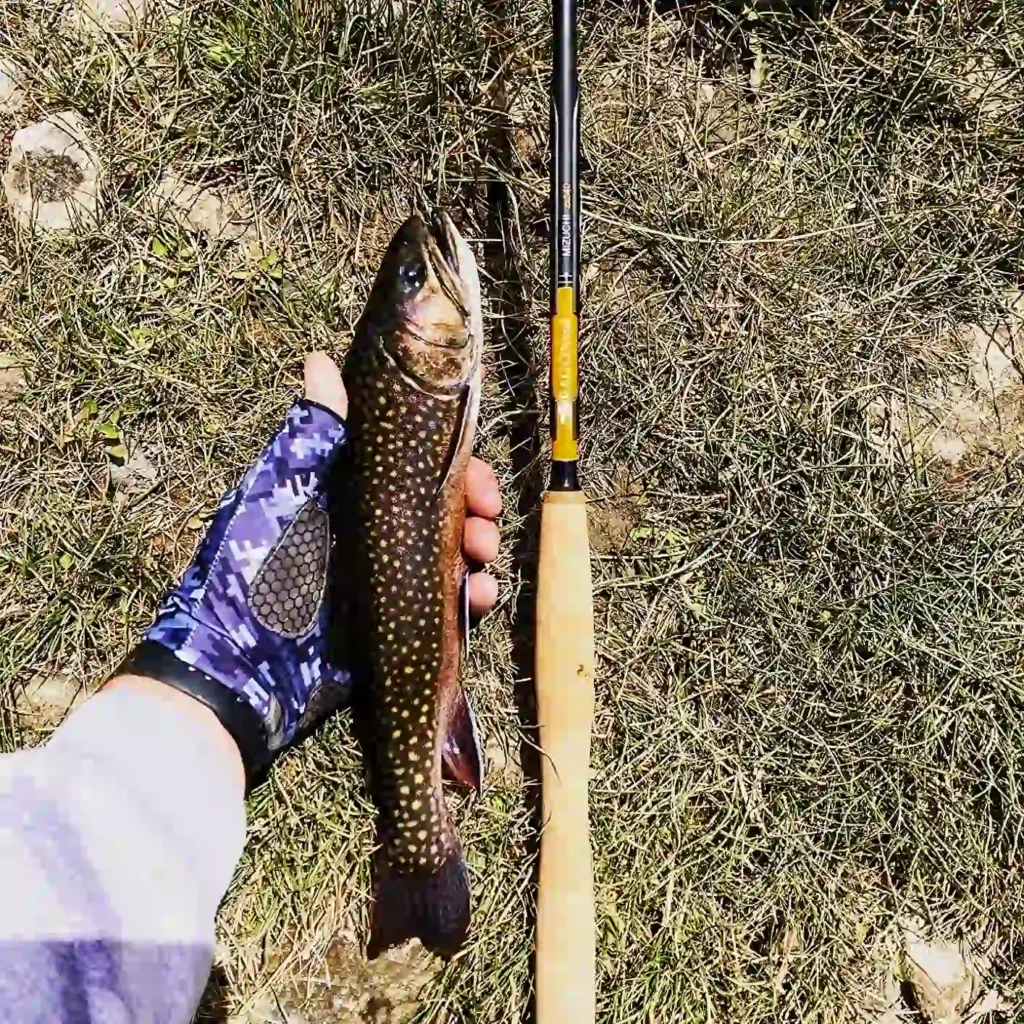
A Tenkara rod is a subset of fly rods with origins in the small mountain streams of Japan. These rods are distinct in that they lack a reel altogether.
Tenkara rods are characterized by their lightweight, robust structure and convenient portability, making them increasingly popular among fly anglers who frequent small streams. While they may not achieve the casting distance of traditional fly rods, tenkara rods are exceptionally well-suited for their intended purpose.
Common Applications:
- Tenkara rods are designed for short-range fly casts, making them ideal for navigating the tight quarters of small streams.
- Suited for targeting smaller fish species, tenkara rods offer a delicate touch and precise control in more confined water environments.
Advantages:
- The absence of a reel and the telescoping design contributes to the lightweight and easily packable nature of tenkara rods, facilitating effortless transportation.
- Tenkara rods offer a simplified fly-fishing experience, eliminating reel complexities and focusing on the fundamental connection between angler, rod, and fish.
Challenges:
- While excellent for short casts, tenkara rods may not perform as well when distance casting is essential, limiting their application in larger bodies of water.
- Due to their design and intended use, tenkara rods may not be the best choice for anglers targeting larger fish species that require more substantial tackle.
Other Factors to Consider While Choosing a Fishing Rod:
After knowing about different types of fishing rods suitable for specific conditions, the following factors play an essential part in selecting the right fishing rod.
Length:
Rod length is a crucial consideration in selecting a fishing rod, as it directly impacts casting distance. Measured from the handle’s end to the rod’s tip, longer rods generally excel in casting over greater distances, while shorter ones are more limited in reach.
However, longer rods can be more challenging to control, making them better suited for experienced anglers.
For beginners, a fishing rod length (around 7 feet) is often recommended to balance casting distance and accuracy.
Material:
Fishing rods are made from three primary materials, each with distinct advantages and drawbacks. Understanding these differences aids in choosing the suitable material for individual preferences:
Graphite:
- Lighter and stiffer than fiberglass.
- A lightweight design is ideal for extended fishing sessions.
- It offers high sensitivity and fighting power but is pricier and more brittle.
Fiberglass:
- Traditional, sturdy, durable, and robust.
- Well-suited for trolling and saltwater fishing due to heavy-duty construction.
- It requires minimal maintenance and is generally more affordable, though it can be heavy.
Composite:
- Blends graphite and fiberglass characteristics.
- Offers a compromise between the performance of fiberglass and graphite rods.
- Suitable for versatile use in various fishing situations.
Action & Power:
Action: A fishing rod’s action refers to the flex it exhibits when bent. It can be categorized as slow, medium, or fast, indicating how quickly the rod returns to its original position:
- Slow Action:
It bends throughout its length, making it suitable for trolling and saltwater applications.
- Medium Action:
It bends halfway, which is ideal for using moving baits.
- Fast Action:
It bends mainly at the tip, which is excellent for casting lures.
Power: Power denotes the force needed to bend the rod and signifies its resistance to turning, ranging from ultra-light to ultra-heavy:
- Light Power:
It bends easily and is suitable for trout, panfish, and smaller species.
- Medium Power:
Requires intermediate weight to bend, appropriate for bass, pike, etc.
- Heavy Power:
Difficult to bend, designed for larger fish like salmon, catfish, and other robust species.

